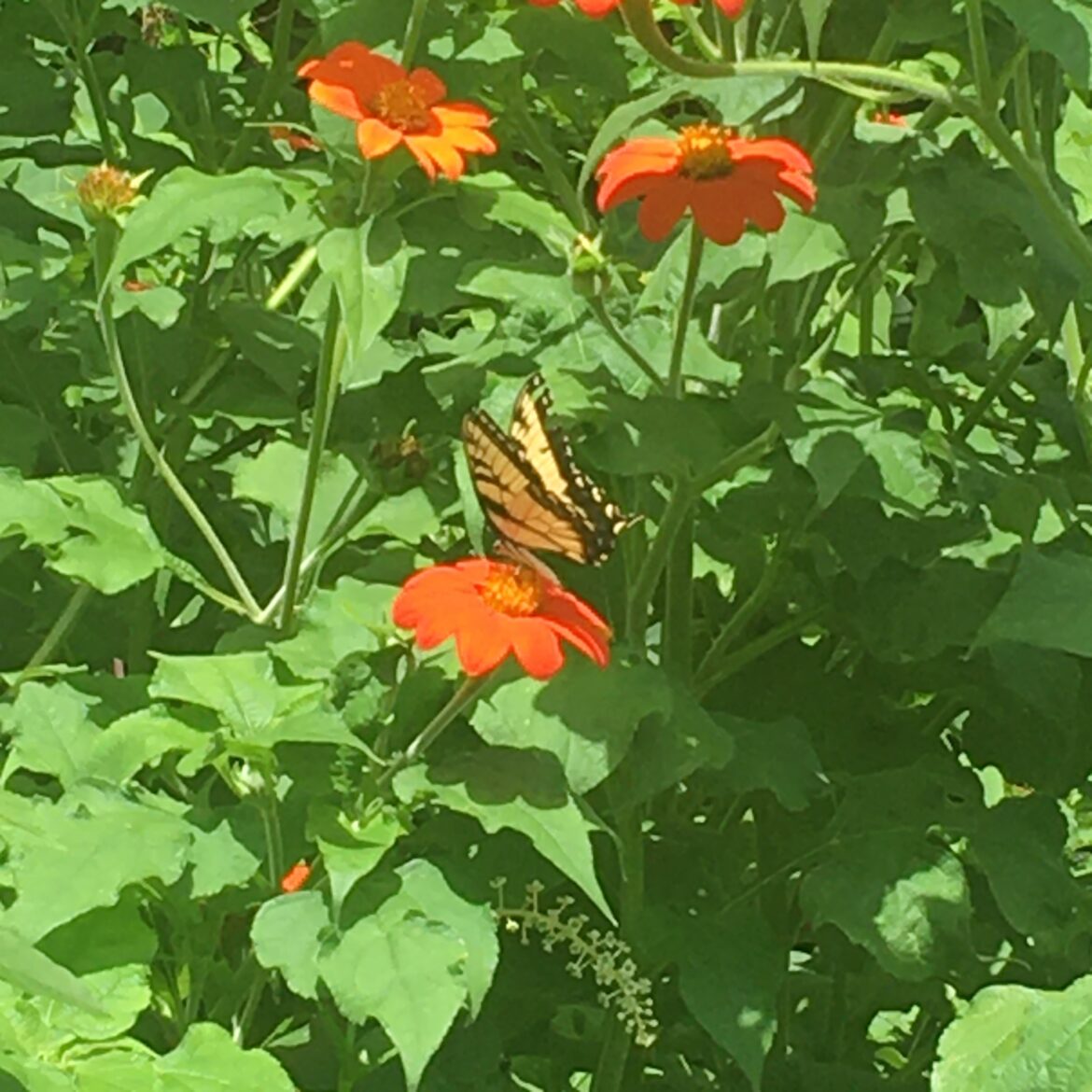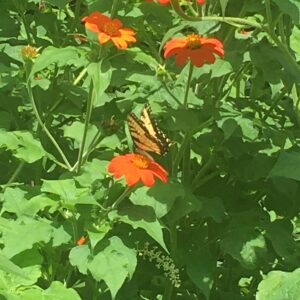August 6th
The 218th Day of the Year
No marigolds yet closed are;
No shadows great appear;
Nor doth the early shepherd’s star
Shine like a spangle here.
Robert Herrick
Sunrise/set: 5:38/7:43
Day’s Length: 14 hours 5 minutes
Average High/Low: 85/64
Average Temperature: 74
Record High: 101 – 1918
Record Low: 49 – 1994
Weather
Thirty percent chance of a high in the 90s today, 35 percent for 80s, thirty percent for 70s, five percent for 60s. Rain is likely one year in three. A nighttime temperature in the 40s is possible now for the first time since the first week of July, a sign of the strength of the August 4th cool front, and a statistical step to autumn.
Natural Calendar
As Late Summer begins, all the katydids are singing. They call out the close of the Dog Days, and even though heat often lingers, the rhythm of the season has shifted, its tones have been altered, colors and sounds and scents all pointing to fall.
Now, almost everywhere in the country, average temperatures start to drop a degree and a half every seven days until the middle of September, at which point they decline about one degree every three days into January. Migration clucking among the robins increases. Some days, there will be a long and steady cardinal song before sunrise, then silence. Hummingbirds, wood ducks, Baltimore orioles and purple martins start to disappear south; their departure marks a quickening in the advent of Early Fall.
Cottonwoods are yellowing. Black walnut foliage is thinning, foretaste of the great leafdrop to come. Locust leaves turn brown, damaged by leaf miners. Violet Joe Pye weed grays like thistledown. The prickly teasel dies back. Fruit of the bittersweet ripens. Spicebush berries redden. Tall goldenrod heads up. Rose pinks and great blue lobelia color the waysides. In the thunderstorms of Late Summer, green acorns and hickory nuts fall to the sweet rocket growing back among the budding asters. Spiders in the woods weave their final webs, and fireflies complete their cycle.
Daybook
1985: First boneset blooming at the frog pond near Grinnell Road. White snakeroot very early. First buds on the goldenrod. First yellow jacket seen.
1986: Only sporadic cardinal song today. No sparrows or robins. Grackles gone from the back trees.
1988: Mill Habitat: First white snakeroot. Jumpseed blooming, love vine, gold now, covers the lizard’s tail all along the river. A clump of showy coneflower, Rudbeckia speciosa, is in full bloom by the dam.
1990: Jekyll Island, Georgia: Pennywort blooming, pokeweed berries half purple, half green, thick-leafed bindweed in bloom, varieties of trefoil with big, blue one-inch flowers, purslane, Virginia creepers, thorned greenbriar. Ragweed still not in bloom here.
1993: First bright blue dayflowers opened today. Through the village on my walks, a stability of purple coneflowers, violet mums, violet, white, and red phlox, golden coreopsis, showy coneflowers, tall coneflowers, bright zinnias and cosmos that will all last into September.
1997: This morning, the cardinals were loud at 5:00, but no robin chorus. That chorus is gone for the year now, ending with the last ten days or so of July. This afternoon into South Glen: One black walnut on the path. Early ironweed and wingstem. Blackberries mostly red. Wood nettle still full. Daddy longlegs do not have red eggs attached to their legs now. Full bloom of the oxeye.
1998: A cicada emerged last night on the back screen door, his old ecktoskeleton left hanging.
1999: Out for a walk along the Little Miami River: Virgin’s bower, purple phlox, wingstem in bloom. In town, two resurrection lilies seen flowering. This afternoon, the first yellow jacket came to the fallen apples.
2002: At 5:40 a.m., only crickets heard, the whistling crickets and the tree crickets. At 5:46, the first faint cardinals. Crows at 6:03, then doves almost immediately after. One jay call at 6:10.
2003: Five tiger swallowtails in the garden today. One black swallowtail was engaged in randori with them.
2005: Bud Marsh from Livermore Street called this afternoon to report at least half a dozen hummingbirds were swarming at his feeder. Although he remembered that the previous instance of this kind of end-of-summer clustering had taken place in September, a quick check of sources on the Internet suggests that this year Bud observed male hummingbirds as they were clustering for migration a month or so ahead of the females. In northern states, the male swarming can take place as early as July. Since Bud also saw hummingbird flocks in September, it is likely that those birds were females with their young, gorging themselves with sugar before their flight south. September 30 is an average date for the last hummingbird to leave Yellow Springs.
2006: The first ironweed buds were open this morning.
2007: Yellow leaves from the white mulberry, locust, and hackberry trees fall sporadically now in the breeze. The leafdrop has begun.
2008: To Portland, Oregon: Yellowing of a few trees along the Columbia River valley. Goldenrod prominent.
2010: Cardinal at 4:56, Crows at 5:23. Swallowtails, skippers, red admirals and monarchs continue as the sun reaches the butterfly bushes. Only six raspberries from the new patch today. Fallen black walnuts and apples in the alleyway.
2011: Portland, Oregon: Very little bird or insect song here in the suburbs, no flies, no mosquitoes, the land dry. Yucca in full bloom, mallow, Shasta daisies, some late wisteria, many lilies and large-flowered magnolias still have blossoms. Some blackberries ready to eat, some salmonberries red, soft, sweet.
2012: One loud cardinal outside my door at 5:03 this morning, robins already singing. In the garden, white bindweed flowers are multiplying. Many hosta leaves deep ochre. Heliopsis, phlox, knockout roses, one cluster of yellow tea rose blossoms, full showy coneflowers, an occasional reblooming lily (and Don has one lily plant still in full bloom), the faithful catmint, a few scraggly purple coneflowers (although Liz’s and the ones in the Women’s Park are still quite strong – but their petals fading), raggedy Shasta daisies, banks of zinnias providing almost all the color.
2013: Mateo’s back lawn full of yellow leaves from the black walnut tree at the east edge of his property. At least three male tiger swallowtails in the yard today, always a female nearby. At Ellis Pond, the first arrowhead is blooming. From Vermont, Cathy writes: “It turned cold here yesterday. We had a thunderstorm and it hailed. Large pieces the size of peas covered the lawn and the deck. What a clatter! It feels like fall has come. Sweater time. Forecast says it will be in the 50s at night and 70s in the day. I saw several maples with leaves starting to turn, but maybe they were problem trees. Roadside weeds are turning beige. Fast forward climate change.”
2014: Eight lily plants still have at least one blossom each. Moya’s late-blooming, white-flowered hostas are almost ready to open, and the large hosta near our pond has substantial buds. A parent was feeding her fledgling sparrow in the honeysuckles, back and forth from the bird feeder every five to ten seconds, the young bird fluttering its wings almost the whole time. This afternoon, a large spicebush swallowtail came to the zinnias and stayed for about five minutes, sampling the different colors. I have been seeing the small golden skippers over the past week or so. Tonight was so loud with the static crickets and the high, steady crickets and a few field cricket chirps and the deafening katydids.
2015: Rain and cold all day, but cardinals singing throughout, starting a little after 5:00 – in spite of the fact that Jeanie used to say that the rain was about to stop when birds sang. I built a fire in the stove, closed the window to a chilly east wind. Six lilies at home. The Women’s Park garden is still lush, but the golds and violets are fading just a little. Some coloring to a few serviceberry trees. Here, the zinnias, Joe Pye and the amaranth are drooping from the rain. Only the aggressive tithonias hold up – as they push out the other annuals.
2016: Walk with Jill, near Penn Yan, New York, a long path along the canal and then the river. Varied vegetation, most at the same level as in Yellow Springs. Joe Pye weed is fresh in full bloom here, Queen Anne’s lace and purple loosestrife common, scattered heal-all, bouncing bets, one knotweed flower – but almost all the other knotweed plants not even budded. Black walnut leaves were starting to come down.
2017: Overcast, windless, misty and cool, a soft and quiet Sunday morning, secluded with honeysuckles, too early and dark for butterflies, the crickets screeching never pausing, cardinals competing with them, blue jay bell calls, crows,.
Two bumblebees in the last bee balm flower, tiny, shining, gold and orange hoverflies exploring the arching stems of jumpseed full of small white blossoms, more hoverflies checking the seeds of old hostas and the rough leaves of the dark milkweed. The lone resurrection lily of the east garden had toppled over, broken at the base, and when I picked it up, and brought it to the house and dropped it on the floor, half the brittle stalk just broke off.
A spined micrathena spider (a triangle of white and brown and black) in a wide web that stretched from a branch of forsythia to Janet’s redbud tree, and another micrathena between Jeanie’s redbud and a bamboo tree, both spiders returning to the center of their webs on guard when I approached, defiant against impossible odds.
Two fallen peaches, yellow-green, bruised and blotched: when I turned them over with my foot, I saw their undersides rotting dark orange and juicy. Rank pokeweed berries and healthy black and green milkweed pods fat, prickly and sticky beside the ailing peach tree.
Two mosquitoes side by side on my wrist, gone before I could look at them closely enough, but it seemed their legs were fringed with white. Up the north side of the house the fearless, invading euonymus vines flowering in my face, and then the doe that lives between my house and Moya’s emerged to eat the Anna Belle hydrangea, and then a fawn sidled in beside her.
2018: The katydids started calling at 7:54 this evening, the earliest yet.
2019: Three ditch lily, one day lily, 13 resurrection lily blossoms. At the Glass Farm habitat, prairie grasses and gray-headed coneflowers filled the fields, some Queen Anne’s lace and thin-leafed coneflowers mixed in. Ragweed was heading up, a few plants ready to bloom. First painted lady butterfly (Cynthia: Vanessa cardui) of the summer seen in the tithonias at home. Before the thunderstorm that broke the two-week dry spell this afternoon, three monarchs flew exuberantly around the yard, chasing each other, one even chasing a sparrow. Many tiger swallowtails in the garden throughout the day. Katydids started at exactly 8:00 p.m. A few fireflies were still blinking in the yard.
2020: Another cool morning, 59 degrees. Thirteen naked lady plants in full bloom, complementing the pink and red canna lilies. I saw one Polygonia, one azure, one tiger swallowtail, one zebra swallowtail in the zinnias and tithonias today during less than a half an hour outside. Katydids began at 8:04 this evening.
Nature is infinitely layered; the more an eager observer prepares for the seeing, the more Nature reveals of itself.
Peter London



